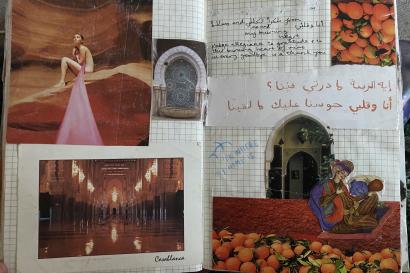One of my favorite dishes while I was abroad in Rabat was rfissa, a dish consisting of stewed lentils (and chicken traditionally, although I’m vegetarian) with onions, roasted garlic, and leftover m’semmen (flaky Moroccan flatbread). While feeling homesick for the flavors and feelings of being abroad, I decided to try and approximate rfissa in my apartment kitchen at home. While I ended up with a poor copy of my host mom’s rich, flavorful dish, it was filling and comforting and tasted similar enough to move me to tears. I thought I’d share the recipe I used (and how I adapted it as a vegetarian college student) for those who might feel a similar withdrawal from Morocco’s unique and delightful cuisine.
Rfissa is not a fancy dish, more of a comfort food, using up leftover bread and filling the soul, so I was surprised to find that all the recipes online were quite involved and required a lot of ingredients I didn’t have access to without driving to a specialty store. Here is the recipe I used, although there were very few ingredients I didn’t substitute. It actually ended up being not just vegetarian but vegan, and very affordable, so I’d highly recommend it to anyone looking for an easy, filling dish on a budget.
I started by cutting my onion into big strips and putting them in the pot with some olive oil to sauté. One thing about rfissa that makes it very college-friendly is that (if you’re not making the chicken) it can be easily prepared in just one pot. While the onion sautéd until slightly translucent, I washed and sorted my lentils, a meditative process that allowed me to reflect on being able to cook again. While I did occasionally help my host mom chop vegetables or wash lentils, I missed the creative process of cooking while abroad, and it’s felt good to have a kitchen of my own again.
Once the onions were mostly ready, I added in some chopped garlic as well as salt and pepper and my seasonings. This is where things were very much approximated. I didn’t have fenugreek or saffron, two of the key flavorings, nor did I have fresh cilantro. To approximate the flavors I remembered, I used a LOT of dried parsley, as well as a good amount of garlic powder (while not called for at all in the recipe I used, garlic is an essential component of rfissa as I knew it) and powdered ginger. I also added turmeric, since it has a similarly soft flavor to saffron, and cumin. Many of the flavorings used in Morocco, like fenugreek, are quite uncommon here, but I really recommend using fenugreek if you can get your hands on it. I let this mixture sauté for a few minutes, then added in the lentils and the water.
Typically, the lentils are supposed to be stewed with the chicken and its broth. I obviously didn’t have chicken broth, nor did I have any veggie stock on hand (although I recommend using veggie broth if you have it). To approximate the umami flavor of the broth, I added some soy sauce and vegetarian poultry seasoning. I can just imagine my host mom poking fun at me for the number of substitutions I made, and I was doubtful it would come out tasting right, but I decided to trust the process. I allowed my concoction to come to a boil, then reduced it to a simmer for awhile.
When the lentils were about half cooked, I decided the stew was looking too liquidy. Rfissa is a thicker consistency because it’s supposed to cook for several hours. I didn’t have this kind of time, so I filtered out about half the broth (and jarred it for later). After that, I allowed the lentils to finish cooking with the lid off to allow the water to steam off. They cooked down into a beautiful rich stew. I plated them over some strips of stale tortilla, since I haven’t been able to find m’semmen, and poured some of my saved broth over the mixture. If you cut your flatbread in wide enough strips, you should be able to eat it as rfissa is meant to be eaten, by using the bread to scoop up the lentils with your hands.
I’m not sure how it happened, since I pretty much didn’t do anything as I was supposed to, but it came out tasting just like home. And I think that’s a good way of looking back at my study abroad experience: it was uniquely mine, and although it was a once-in-a-lifetime semester, I’ll carry these flavors and these memories with me everywhere I go.

Mariama Regaignon
I'm from NYC and attend Bryn Mawr College near Philly! I'm passionate about film, social justice, backpacking, fashion, jewelry-making, reading, and plant-based cooking. When I'm at home I love exploring the city or hanging out with my two cats.








